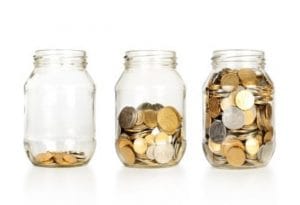In the previous article, we looked at some of the limiting beliefs that get in the way of not only financial freedom, but also health. We announced that stress is just another name for fear. Money, which is strongly linked to the fear of failure or abandonment, can be one of the main triggers of poorer immune and other defence systems.
How to change your attitude towards money or attract it into your life
Here are three exercises that can help you on your way to resolving financial fears, tuning in to materiality and achieving prosperity. The first will help you to soften and change your beliefs, the second will give you a concrete way to make more money in a very elegant and unobtrusive way, and the third will help you to effectively change your spending and saving habits.
All three exercises are very simple and effective. You don’t need any special preparation or equipment, just the determination to do them and some time.
Exercise 1: Identifying responses to specific beliefs

The first exercise is to write down an important belief and check how we respond to it.
Take a notebook or open a writing programme on your computer. ( Handwriting works much better, by the way, because it connects better with the content by creating new neural pathways, of which we create many more by handwriting than by typing.)
On the left-hand side, write a belief about money in the same way as you would say it to someone in a conversation. Include your name in the sentence. Example: “I, Peter Skala, deserve abundance.”
On the right-hand side of this sentence – or, if you are using a computer, below the sentence – write down the genuine response or the first thought that comes to mind when you write it. Let’s say, ‘Hmm, I don’t know if that’s quite true…’ (As mentioned, the exercise will be much more effective if you do it with a pencil and a piece of paper. Not only will you have more time to form a feeling or response within yourself, but every gesture you make on the paper will reflect a clear and specific intention.)
Then write the sentence again on the left-hand side, this time as someone else would say it to us: “Peter Skala, you deserve abundance.” On the right hand side, we again write down what we feel. For example, “It would be nice to hear something like that from people whose opinion I value.”
Then let’s write the original sentence again, but now as we would hear it if others were talking about us: “Peter Skala truly deserves abundance.” And on the right hand side, again, the reaction to it.
The complete cycle – sentences in all three forms and their responses – is repeated, always in the same order. Each time, we write down on the right-hand side the first thought that comes to mind when we write the sentence.
Keep doing the exercise until you start repeating the thoughts, or until your responses are positive and evoke joy or pleasant feelings. This is the first sign that we have, at least temporarily, accepted that we deserve abundance, so we can be more open to the flow of money.
You can continue the exercise with another thought. Choose those that evoke strong emotions in you and are related to work or to getting money, to how much money you earn, to spending, to investing, etc.
Second exercise: unconventional but very effective savings

The second exercise is more practical and suitable for those who pay in cash. Don’t be fooled by its simplicity!
It will take you a few seconds, and you’ll do it when you’re shopping, or when you reach for your wallet. Say, even in the morning, before you go to work.
The task is simple: empty your wallet of all coins, leaving only banknotes. Prepare a special container – for example, a large glass bovla – in which to shake the change.
As you will only have banknotes in your wallet, you will pay with them, no matter how much you have. The seller will (most of the time) return the coins to you and when you get home, you will shake them into the prepared bottle. That’s all … you just have to repeat the exercise or be consistent in the way you do it.
The main point of the exercise is not to touch or use the change in any way. Of course, the more times you do this, the more you save. Some people only remove change from their wallet at the end of the day or in the morning, while others remove it every time they get home.
A friend told me that he takes his family on annual leave every year, just for the money he saves doing so. And he saves it completely without feeling like he is giving up or saving.
It may be a little uncomfortable to implement at first, especially if we think too much in the direction of whether we will be able to live normally despite the coinage or whether we will miss these amounts very much. On the other hand, we can be proud to think that – at last – we have started to save systematically!
Perhaps the idea of a traditional savings system, where you put a few percent back into your account every time you receive money, never really clicked with us. But with this unconventional technique, we can save even more if we are really consistent.
By the way, it often helps to decide in advance what we are going to spend the money we have saved, because then we will be more enthusiastic and consistent. And here’s a practical tip on raising children (in the direction of saving, but it also helps family cohesion): If you are going to save for a family thing, it is highly recommended that the rest of the family follow your example or do the same.
Eventually, the sight of a big bottle slowly filling up with money will be enough to motivate you to continue extracting change.
(If the exercise “sticks” and you find that it makes your life no worse than before – as it most likely will – you can build on it with smaller notes; for example, five euro notes. In this case, always remove these notes from your wallet, in addition to the coins. If, on the other hand, you really feel short of coins, you can only take out cents; that is, all coins smaller than one euro. The key lies in the systematic implementation rather than in the amounts …)
This exercise will have another psychological effect: you will have physical proof in front of you at all times that you have more money than you need. In fact, you have so much that you can even spend it on saving …
The following also help to reinforce a sense of abundance. Keep at least one large banknote on your person, i.e. in your wallet, at all times. If you replace or waste it, replace it immediately with a new one. Every time you see it in your wallet, it will feel better than if it wasn’t there. Of course – after you’ve eliminated any unpleasant concerns and fears you might have at the sight of it (especially if you haven’t carried large banknotes before).
Exercise 3: change your money-handling pattern

The third exercise is also very simple, but perhaps the most effective. The more ingrained your pattern and the more extreme your view on money, the more benefit it can bring you. But you will have to adapt the advice to yourself or your own habits.
Here’s how it goes. Ask yourself what your most common money-handling pattern is. Or what you do when you receive money in your account.
Do you pay your bills and all your (outstanding) debts immediately… and after a few days you don’t have much left in your account? Maybe you treat yourself to something nice “because you’ve worked hard and you deserve it”? Or, on the other hand, do you not afford anything because “after seven fruitful years come seven dry years” and you have to think carefully about where to spend your money?
Many of us are not even aware of how predictable our spending is, or how ingrained our patterns of action are. If we dig a little deeper, we will probably find that we are mostly always guided by the same feelings and thoughts, which then dictate our – again specific and predictable – decisions.
Either way; do it differently this time! If your fingers get itchy as soon as you receive a fresh inflow, hold back now and leave the money in your account for at least a few days.
If you are one of those people who is not rewarded or gifted – and it might be much easier to give the money to someone else – gift yourself again. It doesn’t have to be something expensive. You could go to a show, treat yourself to a day at the spa, pamper yourself at a beauty salon, etc.
In short, change the pattern, then observe your thoughts and feelings. The more you can accept all situations and decisions in a neutral way, the more relaxed you will become about money.
This is one of the key steps when you want to tune in to materiality: allow money to come and go in a more balanced way.
Do you want to really sort out your relationship with money?
Of course, these were just some basic tips and starting points on how to get in harmony with money or increase your wealth.
If you want to do something more in this area, you can use the book “The Big Ugly Crisis“, because it has a whole chapter – called “Cleansing” – devoted to money management, in addition to working on yourself, eliminating conscious and unconscious limitations, and finding harmony in personal relationships.
But let’s not neglect other things. As we have seen in this series of articles, the amount on your account is purely the result of a number of factors. When we change the real causes and live in greater harmony with money, we will also eliminate the stress associated with finances. Our income will not necessarily increase immediately, but we will certainly not be as tormented and exhausted by the financial situation as we have been.
So if you are looking for abundance, or at least for an end to money worries, start with yourself: your beliefs, your desires and your goals. Re-evaluate what you want out of life, then adjust your actions along new lines, or rather, focus on achieving those goals in the first place.
Another tip: The easiest way to find out what’s really important in your life is to look at your personal expenses and schedule. What you actually spend your time and money on makes up your priorities in life. The American esotericist Peter Ragnar (the “longivety sage” or sage of longevity) once said a remarkable thought: “Tell me how you live, and I’ll tell you what you really believe.”
In fact, we will often find that our daily lives reflect very different and different values than those we strive for within ourselves. For example, even though we consider ourselves to be very mature, spiritual and responsible, we may find, by analysing the unfolding of events, that we have not moved on for years – we are still engaged in the same activities and have the same view of ourselves, of others and of the world.
But perhaps it is time to rethink tools and approaches too?
This article is based on books by Boris Vene and Nikola Grubiša.
